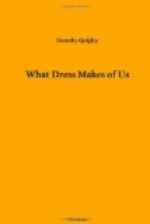[Illustration: No. 56]
A basque cut high behind and on the shoulders apparently gives height.
A very stout woman should never wear double skirts or tunics or dresses with large sprawling patterns, such as depicted by cut No. 56, which suggests furniture stuffs. A large woman who had a fancy for wearing rich brocades figured with immense floral designs was familiarly called by her kind friends “the escaped sofa.”
White, or very light colors, should never be worn by the stout; they greatly increase the apparent size. Large plaids should also be eschewed. Small checks and plaids may sometimes be becoming.
Neither the too thin nor the too stout should adopt a style of gown that caricatures the form as does the voluminous wrapper, finished with a box-pleat, as shown in No. 57. There is no grace in straight lines.
[Illustration: Nos. 57 And 58]
No. 58, which accentuates the height of the over-tall, thin woman, is better adapted to enhance the charms of a woman of finer proportions. The bony and scrawny, of the type of No. 58, seem to have a perverse desire to wear what makes their poverty in physical charms only more conspicuous. A woman of distinction in Boston, who is exceedingly thin and tall, wore Watteau pleats so frequently, even on reception and evening gowns that she was dubbed by a wag “the fire-escape,” a title which so strikingly characterized her style, that the term was adopted by all her friends when they exchanged confidences concerning her.
The garment with the Watteau pleat is not unlike the princesse gown which is a very trying style except to handsomely proportioned women. A tall, well-developed woman, such as shown in sketch No. 59, adorns the princesse gown and attains in it a statuesque beauty. In suggesting statuary it fulfils the true ideal of dress, which should hint of poetry, art, sculpture, painting. The massing of colors; the arrangement of lines, the quality of textures, the grace and poise of the wearer—do not these hint of picture, statue, music?
CHAPTER V.
CORSAGES APPROPRIATE FOR WOMEN WITH UNBEAUTIFULLY MODELLED THROATS AND SHOULDERS.
Despite the traditional belief that a decollete corsage is a tyrannous necessity of evening dress, a woman not graciously endowed with a beautifully modelled throat and shoulders may, with perfect propriety, conceal her infelicitous lines from the derisive gaze of a critical public.
Women are indebted to that gentle genius, La Duse, for the suggestion that a veiled throat and bust may charmingly fulfil the requirements of evening dress, and also satisfy that sense of delicacy peculiar to some women who have not inherited from their great-great-grandmothers the certain knowledge that a low-necked gown is absolutely decorous.
The women who does not possess delicate personal charms commends herself to the beauty-loving by forbearing to expose her physical deficiencies. Unless it is because they are enslaved by custom, it is quite incomprehensible why some women will glaringly display gaunt proportions that signally lack the exquisite lines of firm and solid flesh.




